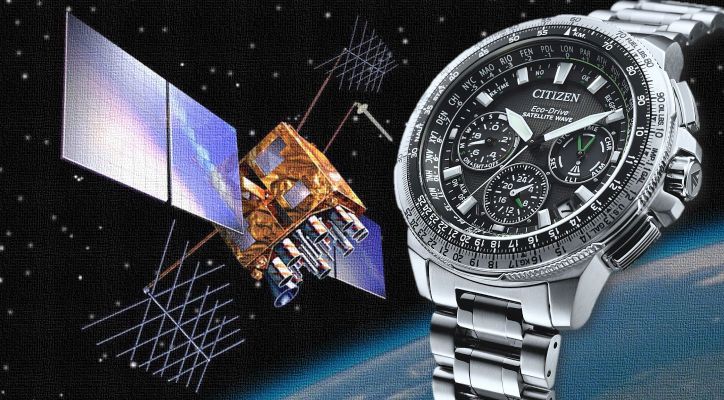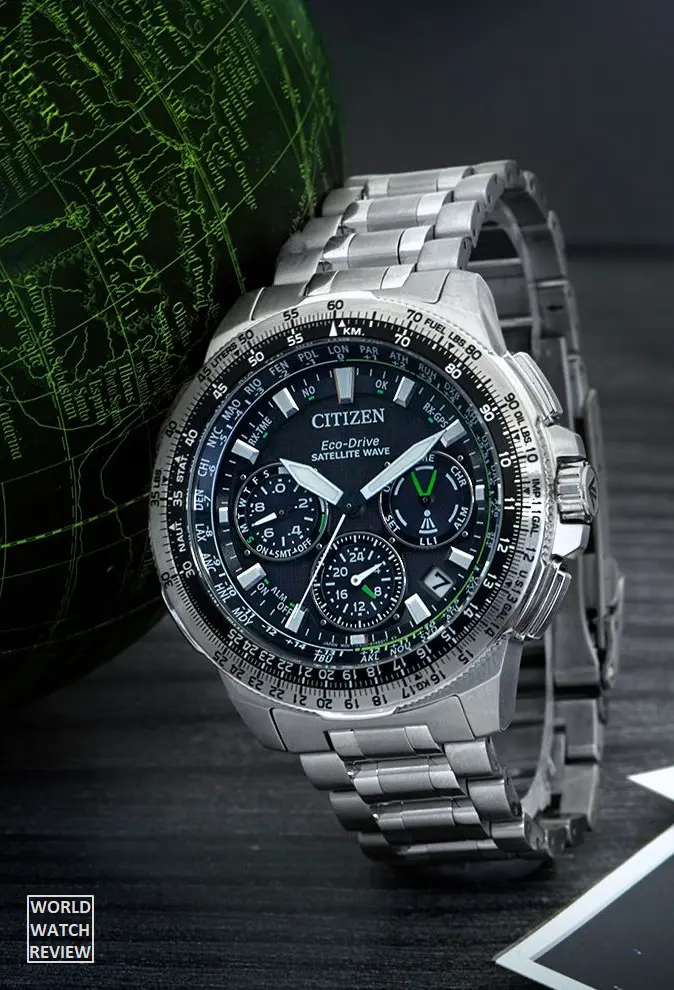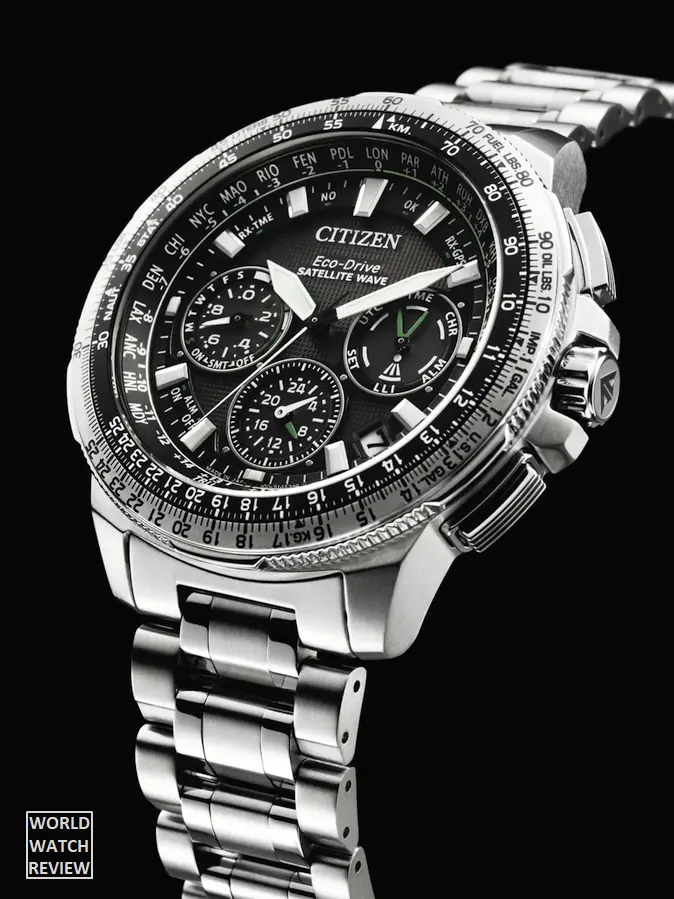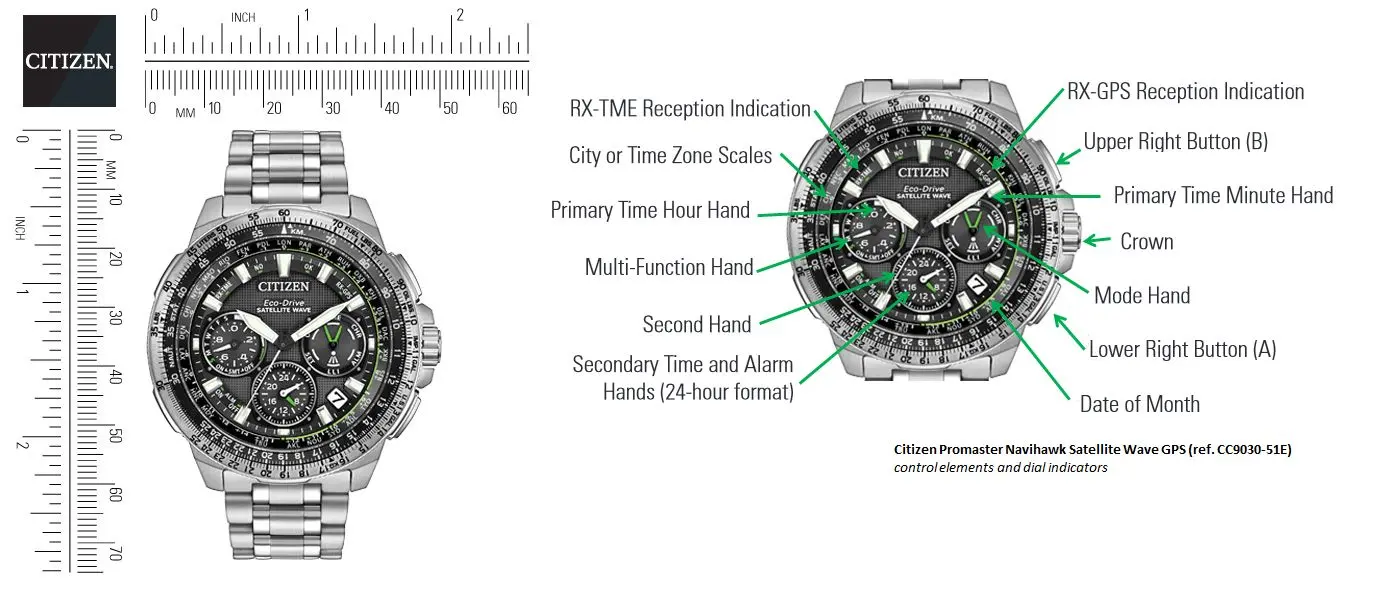
Citizen has been in the business of (also) making GPS-equipped watches for, like, forever. Their Promaster Navihawk Satellite Wave GPS (ref. CC9030-51E) is a fine example of how you can get a lot of know-how, a block of high-grade steel, and a handful of silicon parts and create a wonderful object that can be a watch, a gadget, and even a surprisingly low-priced fashion statement as well!
Overall Impression
As usual for the collection, the new Navihawk features that famous “modern pilot’s watch according to Citizen” styling. One can only describe the approach as “take a brutally oversized case, stuff everything you’ve got in it, and don’t forget to cover every square millimeter of its surface with indicators, markings, and inscriptions.”
The lower-priced Navihawk A-T model with its analog-digital display that utilizes the same approach doesn’t look convincing. This GPS-equipped model, however, looks a lot more interesting. Not in the sense that the design is original or new (it is not in both cases,) but there is something in it that makes it look solid and expensive.

I think it has something to do with the overall quality of the otherwise generic design.
The typefaces both on the dial proper and on the rotating bezel look like they were carefully chosen.
All elements that should be readable in less than optimum conditions are either covered with enough luminous compound to light a small room or printed using a high-contrast color scheme.
The case itself is complex and elaborately finished.
Surprisingly, nothing is exaggerated to a point where you just have to roll your eyes, sigh, and try to un-see it.
Yes, some things don’t look especially great (the solid bracelet is probably the first one that comes to mind, and the size and weight are the second,) but otherwise, the Navihawk makes a strong impression.
No, it doesn’t make my heart go racing. Yet, if I were on the market for this sort of gadget, I would probably make a shortlist of three that I would probably consider as a candidate together. Besides the Navihawk, the list would include such technological marvels as the Seiko Astron GPS Stratosphere (which is dressier and more expensive) and the Breitling Emergency II (which is outrageously more expensive, almost prohibitively so, but also more high-tech).
Hmm, now I think that the choice is obvious.
Case & Bracelet
There is a lot of high-tech machinery inside this mechanical monster and it probably needs a lot of space to successfully pack the GPS antenna and the caliber itself, so the case is predictably big.
At 47 millimeters in diameter, it is a tad smaller than the brand’s earlier attempts at this sort of gadget, but it still leaves an impressive footprint on your wrist. The lugs are short and therefore the total length of the Navihawk GPS is just over 51 millimeters, but (probably to make it look more proportional) the piece is also thick, so some may find wearing it not especially comfortable.
Also, it is crafted not from lightweight titanium like the 2015 model, but from ordinary stainless steel, so it is also heavy and this, too, doesn’t make it more comfortable: you will feel the weight of the case constantly pressing against the back of your hand. They tried to mitigate the problem with a relatively short notched crown (it is protected from lateral shocks with massive crown guards, but still must provide a good enough grip for most people) and a set of wide, but short push-pieces.

Putting ergonomics issues aside, I would like to say that the case makes a great impression if aesthetics is what you care about. The shape of the case is well thought-after, as is the rotating bezel with an inevitable Breitling-style slide rule engraved on it, and the pushers with fine slots in them (the latter will probably attract dirt and dust, but would be easy to clean with something as mundane as a toothpick.)
All in all, I would say that the watch looks like it is worth every penny that Citizen plans to charge for it (see below.) Frankly, I don’t see any serious issue with the shape of this device.
The bracelet doesn’t look convincing, but it is that rare case where Citizen uses a set of standard lugs, so replacing the bracelet with something more “brutally refined” would not be a problem, although this will increase the overall cost.
Dial
The dial on this new Promaster Navihawk GPS may not look as interesting as the one on the 2011 Satellite Wave (ref. CC0005-06E) that featured a linear layout of its sub-dials. At least it is easier to read even despite more threads of information that are simultaneously available to the owner.
The central second hand indicates the modes on the bezel flange (like GPS and local time reception.). The perfectly visible pointers on the sub-dials display all the rest.
If the Promaster Navihawk is your first watch of this kind, you will probably need to spend some time reading the owner’s manual that goes with this timekeeper, but after all is more or less clear, reading all the data becomes sort of natural. Oh, maybe not as natural as that on a device with a high-resolution LCD screen like the recent bunch of smartwatches released by major brands, but sort of natural.
The relatively wide hour and minute hands with all the light-green lume applied to them, too, allow to read the dial in any light.
I have an impression that it is these two indicators (as well as the mid-sized date aperture between four and five hours) that will get 99 percent of your attention after you have done playing with all the fancy functions and started using it as a normal watch. The same goes for the alarm indicator at six o’clock.
Featuring the usual military-style 24-hour display with the standard (albeit tiny) hour and minute pointers, the indicator is easy to comprehend and is also quite useful in case you plan to rest well and sleep more than 12 hours straight (although you probably don’t want to find yourself THAT tired.)

Styling-wise, I would say that this is one of the best multifunctional timekeepers released by a Japanese brand during the last decade. Although not innovative, it is elegant and, well, designed for grown-ups, not for the first-graders as many members of the G-Shock family tend to look.
Mechanism
The Caliber Eco-Drive F900 that powers this new model is the same movement that we have first seen last year when Citizen presented the new iteration of their new Satellite Wave collection of GPS satellite-synchronized timekeepers.
Featuring a satellite signal reception speed of close to 3 seconds as well as a high-speed twin-coil motor that Citizen has ‘specifically’ developed for this new family, the mechanism corrects any error in its readings almost as fast as a blink of an eye. To get the movement synchronized with your current time zone, all you need is to push the dedicated button while standing someplace where the gadget with its tiny antenna will be able to receive a signal from the sky.
Still, even if you don’t want to correct the hands manually (if pressing the button with your finger can be called ‘manual adjustment’,) the mechanism is good enough to keep time gaining or losing no more than five seconds per month. Can’t call this sort of accuracy crazy impressive, but it is still good enough for a quartz watch that is as expensive as this one.
Of course, there is a minor ‘fine print’ to that: after you first start the watch (or, for example, emerge from a place where no GPS signal reception is possible,) the device will still need at least half a minute to figure out where on Earth it currently is. From my perspective, this doesn’t sound inconvenient, but you should still keep this ‘feature’ in mind.
Also, from what I have seen before, the system used by Citizen is considerably (at least 10 percent) faster than similar designs from Casio (I am talking about the 2014 G-Shock GravityMaster here) and wSeiko and is generally more convenient. I mean, you don’t have to press and hold the button for as long, and the aforementioned electric motor that drives the hands is, too, a lot faster.
As with all Eco-Drive movements, the mechanism starts to recharge itself whenever the tiny solar cell on its dial receives enough natural or artificial sunlight to get electrons going inside its layers of, um, whatever material they use to make these particular cells.
As for its reliability, I can say neither good nor bad about this engine: the mechanism is still relatively new and there is still just not enough data to jump to any sort of conclusion. Still, like with any kind of expensive electronic device, you would probably be better off buying it with a full warranty. But it’s sort of common sense, isn’t it?
Pricing & Availability
The Promaster Navihawk Satellite Wave GPS will go on sale later this year with recommended street price €1275 in Europe and $1395 in the United States. As for the rest of the world, the price will heavily depend on your local taxes and customs duties. From where I stand, the price looks interesting for this sort of gadget: it is less expensive than most high-end quartz watches made by Swiss-based luxury brands and it offers more functionality than most of them.
I can’t predict how good it will be at retaining its resale value, but, if you don’t plan to flip it after the first week on your wrist, you probably shouldn’t worry about that either.
See also: Seiko PROSPEX Radio Sync Solar World Time Chronograph
Photos: Citizen
WWR verdict
Originality 3.5/5
Build quality: 5/5
Usability: 4.5/5
Legibility: 4.5/5
Value for money: 4/5
Citizen Promaster Navihawk Satellite Wave GPS CC9030-51E specification
Price: RRP €1275 // MSRP $1395
Power: Solar-powered
Movement: Caliber Eco-Drive F900, GPS-syncing (time adjustment for 27 time zones/cities), Made in Japan
Accuracy: +/- 5 seconds per month
Power reserve: Virtually unlimited
Functions: Hours, minutes, seconds, date, satellite GPS Timekeeping Technology with Worldwide Reception, perpetual calendar, 1/20 second chronograph, power reserve indicator, alarm, military 24-hour indication
Case: Stainless steel
Shape: Round
Size: 47.00 mm
Case height: 15.00 mm
Lug width: 22 mm
Dial: Black
Hour markers: Luminous
Hands: Luminous
Water resistance: 200 meters
Strap: Stainless steel bracelet with fold-over clasp with push-button, alternately polished and brushed links
Crystal: Sapphire
Back: Solid
